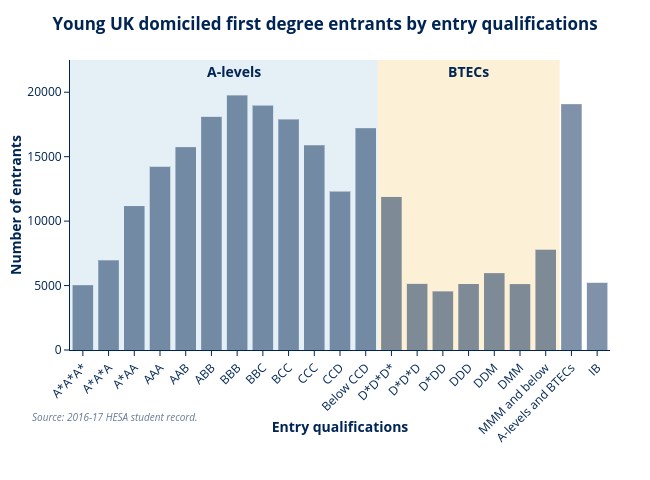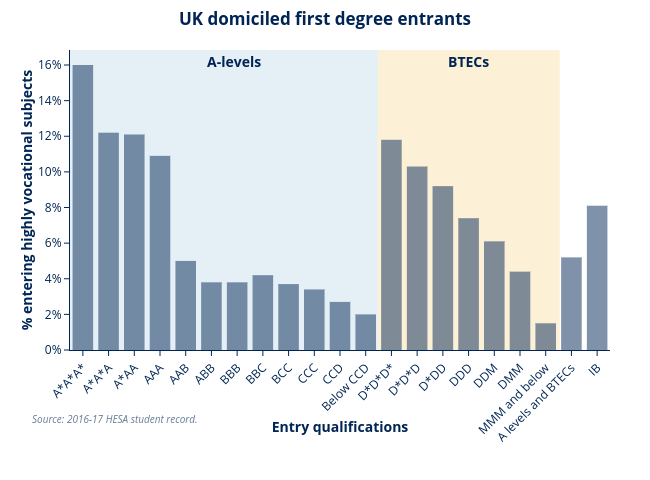OfS analysis shows that differences exist between students entering higher education with A-levels and BTECs.

Of young, UK-domiciled entrants in 2016-17, 72 per cent of students entered with three A-levels. A further 19 per cent of students entered with three BTEC qualifications, 8 per cent of students entered with a combination of A-levels and BTECs and 1 per cent of students entered with International Baccalaureates. The largest group of A-level students were those entering with grades BBB while the largest group for BTECs had three Distinction*s (D*D*D*).
So where are these students going and what are they studying?
98 per cent of students with A-level A*A*A* are going to high tariff institutions whereas only 21 per cent of students with BTEC D*D*D* are going to the same institutions.
Physical sciences and medicine and dentistry are the most popular subjects for students entering with A*A*A* at A-level, with 16 per cent and 15 per cent of students respectively. Students entering with CCC mainly go into business and administrative studies, and biological sciences (14 per cent and 13 per cent respectively).
The most popular subjects for those who come in with BTECs of any grade are biological sciences, business and administrative studies, and creative arts and design.
For students entering with International Baccalaureates, subjects within social studies are the most popular.
Given the differences in subjects, is this because certain Level 3 qualifications lend themselves to more vocational courses?
Using a new measure, developed by HEFCE, to show how vocational each subject is, we find that 6 per cent of all entrants in 2016-17 were in subjects that are classed as highly vocational - but this percentage varied by entry qualification. The highest was for students with A*A*A* at A-level, with 16 per cent. For D*D*D* at BTEC, 12 per cent of entrants were studying highly vocational courses.
However, the subject concentration for highly vocational courses is very different for students with different entry qualifications. For students with AAB and higher at A-level the students are concentrated in medicine and dentistry disciplines, as are students who enter with International Baccalaureates. For all other entry qualifications the highly vocational courses are concentrated in subjects allied to medicine.
So, once they are at university, how do their outcomes compare?
Outcomes at the end of the first year are varied. Only 1 per cent of students with A*A*A* are no longer in higher education, and this increases to 6 per cent for students with three A-levels below CCD. However, students with D*D*D* at BTEC have a higher non-continuation rate than all groups with three A-levels, with 10 per cent of students no longer in higher education after year one. This increases to 21 per cent of students with MMM and below at BTEC.
Differences in degree attainment have been looked at in a HEFCE blog post and showed that the outcomes are similar to those seen in the non-continuation rates. Students entering with A*A*A* have the best outcomes - with 95 per cent of students gaining a first or upper second class degree. This compares with 71 per cent of students entering with BTEC D*D*D*.
So what can be done?
Our analysis shows that the majority of students entering higher education with BTEC qualifications are achieving successful outcomes. But it also shows that there are gaps that need to be addressed between those entering with A-levels and those entering with BTECs - both in terms of where and what they study, and of non-continuation and degree attainment.
The reasons behind these gaps are likely to be complex and multifaceted. Consideration needs to be given to how BTEC students’ experiences pre-HE can be enhanced to better prepare them for higher level study.
Equally important is the need for higher education providers to examine their provision and support to ensure that it is inclusive and enables those students from all backgrounds and with varied entry qualifications - who have the desire and the ability to participate in HE - to achieve successful outcomes.
Some HE providers are already undertaking work to target this through our ‘Addressing barriers to success’ programme. The lessons learned from these projects will be helpful to others as they work to address the gaps in their own contexts.



Comments
Report this comment
Are you sure you wish to report this comment?